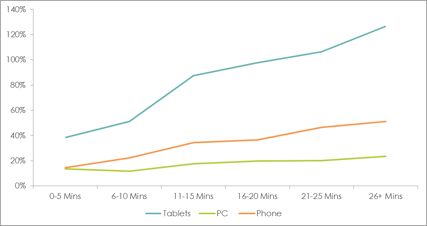Our industry is at a cross roads, not for the first time. More than ten years ago, the online revolution transformed the way marketing research was conducted and allowed us to tap into a more readily available set of respondents.
Fast forward to today and a similar shift is underway with mobile. Our need to engage willing survey participants is again a driving factor. This time, however, it’s from traditional, static online to online on-the-go. This shift is arguably a lesser transformation than an offline mode moving to surveys being programmed, completed and returned through an online platform. But it is nevertheless significant.
As we saw in the previous decade, our industry uptake has been slow. Perhaps there is good reason for this. A survey on a desktop computer is by no means the same as a survey on a mobile and tackling these differences can seem daunting, intensified as respondents expect a seamless experience regardless of what device they are using. In addition, our own technical skillsets are having to transition to accommodate this change.
However, respondents like it. Asia-Pacific accounts for over half of the world’s mobile users and connectivity in both South East Asia and Oceania now exceeds 100%. Not only do they use mobiles frequently, but they also feel a real attachment to their device- 41% of Australians report that they cannot live without it.
But is the industry moving at the same pace as consumers? No, as much as it pains to me to say. At this point, upwards of 40% of new panel joins we see are via mobile devices. Yet the proportion of mobile surveys sits far below this.
Keeping respondents engaged and active requires us to look to surveys that work on all devices. This allows the respondent to make the choice of what device to use. Without this, you could be turning your participants away at the door.
We see significantly higher dropout rates among those opting to use a mobile device and we see higher attrition rates for those joining the panel via a mobile device.

The good news is it doesn’t need to be as challenging or costly as it first seems. There are a few simple ways to make surveys device agnostic at a basic level;
- The shorter the better – our research suggests that surveys under 15 minutes will reduce dropouts and keep respondents engaged.
- Use the natural resources of the devices – e.g. the use of touch in mobile – respondents expect surveys to act similarly to web pages and apps that they use frequently. Respondents will question why they can’t swipe or pinch when faced with a question that needs it.
- Engage the respondents with better designed questions. For example, utilize HTML tools rather than Flash tools since Apple devices cannot display Flash content.
- Keep grid/matrix questions to a minimum. Instead use dynamic grids that are more engaging.
- Limit number of open ended questions to two.
- Re-think the questions we want respondents to answer.
- Use short, concise question text Limit or even eliminate the number of questions with eight plus answer choices
- Limit horizontal scales to seven scale points and test display on multiple devices
- Design for all devices (not just PC)
- Utilize responsive survey design so text/material adjusts automatically to screen size
If we succeed in building a positive relationship and trust with respondents through surveys, mobile could truly be the saviour of the industry. The window to act is still open.




